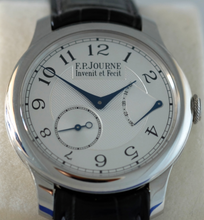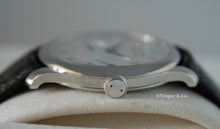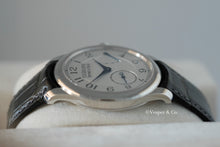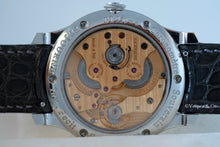
F. P. Journe. A Fine Platinum Wristwatch with Power Reserve
Model: Chronomètre Souverain
Reference: 2xx-CS
Circa: 2007
Cal. 1304 18k pink gold mechanical twin barrel movement, 22 jewels, silvered engine-turned dial, Arabic numerals on a polished chapter ring, subsidiary seconds between 7 and 8 o’clock, fan-form power reserve sector at 3 o’clock, circular three-part case, sapphire crystal display back, platinum F.P. Journe buckle, case, dial, and movement signed
40mm
Accompanied by an F.P. Journe presentation box and Warranty
More about F.P. Journe
In 1999, Francois-Paul Journe launched Montres Journe S.A., to create and produce watches of his design. For the first four years, the regular series of watches featured movements made of brass, and from 2004 onward, the movements were produced in red gold (with the exception of some limited edition watches). Dress watches fell into two different collections – Souverain Collection for watches with manual wind movements, and Octa Collection for watches with automatic movements.
The Chronometre Souverain, also known as reference “CS”, was first introduced in 2005, and that same year won the Grand Prix d’Horlogerie de Geneve award for Favorite Men’s Watch. F.P. Journe created the watch with the focus being on precision chronometry, starting with the dial design, as he does on all pieces. For this model, the power reserve indicator would be placed at 3 o’clock, with the intention of placing it close to the part that would control it’s indication – the winder. As this was not the standard location for the power reserve, Journe would have to reconfigure the movement, and in doing so created a new ultra-thin power reserve indication system (which was patented and used on many of his future movements). A typical power reserve indicator in the watch industry shows the number of hours the movement will run for, and counts down to zero. On the Chronometre Souverain, the power reserve shows zero when fully wound, and points to the number of hours since the watch was last wound, in this case 56. This was not just to differentiate his model from other chronometers on the market, but to keep his model consistent with its inspiration – traditional marine chronometers also indicated the number of hours since last wound. Lastly, Journe used two mainspring barrels in the movement for the purpose of ensuring the power reserve would be more consistent and not run too fast or too slow. In the watchmaking industry, the typical use of two barrels was strictly to lengthen the amount of time the power reserve would hold.
Starting in 2006, the model was available in both 38 or 40mm diameters, and cased in either red gold or platinum. The dial features several classic “Journe” design traits, including the use of guilloche, blued steel hands that taper after the first few millimeters from the post, and “eccentric” or off-center subsidiary seconds and a power reserve indicator. While F.P. Journe would further develop the Souverain line to include a tourbillon model and a grand sonnerie model, the orginal Chronometre Souverain with time-only functionality was well-received and would be the first of Journe’s models to reach the milestone of having 1000 examples made. The present watch is a fine example of how a Journe watch may appear to be an elegant dress watch at first glace, but as with all of his creations, there is much more than meets the eye.









